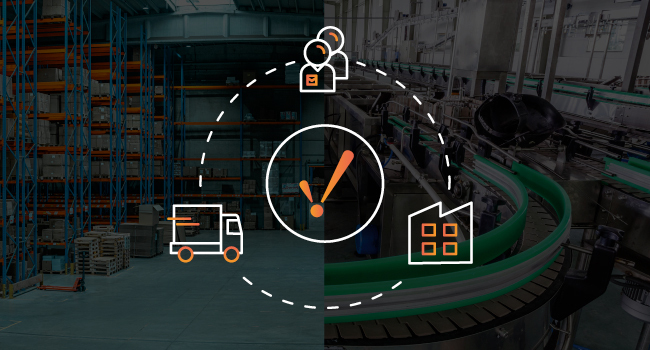How Ignition is Helping Companies Break Free From Supply-Chain Issues

Industrial integration by definition requires constant adaptation. Each project is unique, owing to its industry, scope, and complexity, down to the hardware and software. Complicating matters further is the relatively low number of projects that remain completely unchanged from conception to completion. All of which makes the cavalcade of supply-chain issues in the past few years — and especially the past few months — even more frustrating.
Ross Sheffler, a Control Systems Integrator III at Vertech, described the difficulty of mapping out a project in the current climate. “We'll order a PanelView one week, and it'll be four months, and then the next week we'll get a lead time of six months. It's really been difficult to juggle all of these different lead times,” he said. “It's been causing bottlenecks.”
“There's a lot of logistics that go into these projects, there's a lot of project management that comes into play, and finally the stars all align, you get a project approved. You've got the right personnel, and then you sit and you wait for hardware. While you're waiting, the company keeps moving,” said Kent Melville, Sales Engineering Manager at Inductive Automation. “Personnel gets reassigned to other projects and then once the hardware actually gets there, you're back to square one and it just becomes a nightmare.”
Unfortunately, due to the severity and widespread nature of supply-chain problems, it is unlikely that integration will go back to “normal” anytime in the near future. However, being well-versed in adaptation, integrators and industrial organizations along with software and hardware manufacturers are discovering innovative ways to break free from the supply chain and successfully complete projects.
Supply Chain as Gordian Knot
How did the global supply chain get so backed up? With the outbreak of COVID-19 in early 2020, companies worldwide projected an immediate drop in demand and temporarily halted or reduced production. Demand, though, proved to be more multifaceted than predicted. All at once, the entire planet required high-quality surgical masks along with other forms of personal protective equipment (PPE). Cargo vessels began delivering to regions along less-traveled and new routes, resulting in empty shipping containers piled up across the globe.
Similarly, non-PPE demand did not plummet as expected. Instead, it moved online. The size of individual orders shrank while the quantity of orders increased, dramatically outpacing shipping-container availability and causing shipping costs to rise by an order of magnitude. At the same time, labor shortages left empty containers monopolizing dock space or floating at sea as ersatz warehouses, all while their landlocked counterparts were filled almost to capacity in order to accommodate this new style of demand.
Pre-pandemic, many companies relied on lean production practices, using “just in time” manufacturing operations management to reduce on-hand raw materials and streamline ordering. Integration projects are not continuous like manufacturing and integrators themselves are less bound by geography, making “just in time” not one tactic of many so much as the only practical option.
So, if just in time is months away, what can be done right now?

New Fixes with Classic Solutions
Oftentimes, products are developed to accomplish a specific task or more general goal, but that doesn’t prevent a product from having applications beyond its original intent. Such is the case for Ignition Edge Panel. A standalone HMI software product, Ignition Edge Panel enables users to rapidly build local HMIs for field devices and HMIs for industrial devices. “People wanted a lightweight version of Ignition that was for small sites, for small projects,” Melville said. “And now a new problem comes along with the supply chain and you look at Ignition Edge and you say, you know what, Edge Panel really is a solution for how we can reduce lead times when you're trying to deliver HMIs.”
Ignition Edge Panel offers two critical advantages over a more traditional HMI that become even more significant in the context of a backed-up supply chain: hardware agnosticism and fast installation.
Choose Any Hardware
Agnosticism is key for sourcing hardware. “You can choose from a variety of inexpensive commodity hardware products, instead of being locked into using expensive proprietary hardware,” said Melville. Edge Panel runs on Windows, Linux, and macOS, and is compatible with a wide variety of devices, including more readily available hardware not traditionally found on the plant floor.
“If we can't get a specific touch-screen from a specific manufacturer, since Ignition Edge Panel is hardware-agnostic, we can just switch out the hardware to another outfit and kind of shop around for who has the best lead time,” said Sheffler. “As long as it's a computer and is compatible with the software, you can just mix and match and get any kind of hardware that's available, and that's becoming the name of the game right now.”
Install or Replace Quickly
The second advantage concerns a more topical problem. With current lead times being what they are, failing hardware and, by extension, process downtime can be catastrophic. Melville breaks down a potential scenario: “If your HMI is an isolated all-in-one unit and it failed, you'd have to replace it with the same all-in-one unit, and you'd need to restore the project that was on it, but if it's [a] decoupled HMI, and it fails, you can just install it on a new panel PC of any brand, install the same software. You're back in business, much simpler and more economical.”
Ignition Edge can be pre-imaged on Ignition Edge Ready devices from several trusted hardware manufacturers who have partnered with Inductive Automation. Devices labeled as Ignition Edge Ready have been confirmed by the original equipment manufacturer (OEM) to meet Inductive Automation's compatibility standards for Ignition Edge software through a self-validation process. You can activate Ignition Edge Ready devices by purchasing an Ignition Edge license from Inductive Automation.
New Ignition Edge Capabilities
Ignition Edge Panel makes for an effective visualization solution and it also includes all of the features in Ignition Edge IIoT, which greatly expands your edge capabilities.
Ignition Edge IIoT allows you to transmit and synchronize data with the MQTT Sparkplug specification, decoupling infrastructure from applications, and acts as a conduit for sending real-time data, alarm information, and historical data to a centralized Ignition system through an Ignition-specific Gateway Network. Edge IIoT gives you the option to create REST APIs so you can leverage third-party systems such as line-of-business applications. It also has Python scripting capabilities and gives you the option to initiate custom events and sequences.
Finally, Ignition Edge IIoT can also act as a remote Enterprise Administration Module (EAM) Agent Gateway, enabling you to manage HMIs throughout a facility or across a dispersed network and push out licenses, upgrades, and updates, remotely saving backups, moving tags, and more. With EAM capabilities, swapping out old HMI hardware becomes even easier as the central gateway manages the backups and can quickly restore the latest setting on the new HMI with a simple click. This level of control and speed elevates Ignition Edge Panel to an incredibly powerful integration tool no matter the state of the world.

Large-Scale Solutions for Large-Scale Projects
While HMI solutions may be crucial for sourcing and replacing equipment, many integrators working on the enterprise level are turning to the full Ignition platform as an affordable and flexible means to meet the constantly shifting dynamics of modern projects. Ignition — which encompasses SCADA, HMI, IIoT, MQTT, data historian, MES, and more — excels both for projects that are comprehensively planned out as well as situations where requirements are continually evolving. This is due to Ignition’s modular design and unlimited licensing model.
Ignition’s modularity allows integrators and end users to design systems that exactly match their particular project or, more recently, best synchronize with available materials and hardware. By trading pre-configuration for customization, Ignition provides the tools to create solutions that cover the spectrum from single-process monitoring and visualization to data collection and analysis across multiple sites. It’s also worth noting that while Ignition does not come pre-configured, it does have a Quick Start feature built in and the Ignition Exchange is filled with hundreds of free templates and assets to help accelerate development.
The unlimited licensing model is the most unique aspect of Ignition and, given the current supply chain, also its most vital. Unlimited licensing means unlimited clients from a single license, with the option to continually add more as needed. The model offers the flexibility to upgrade a system, for example, with minimal hardware, just to get the project running. Then, back-ordered hardware can be implemented and instantly connected once it becomes available.
Don’t Let the Supply Chain Hold You Back
With no end in sight for supply-chain problems, some integrators have been forced to adopt less-than-ideal solutions. “They're going to eBay and they're paying more for used products than the retail cost of a brand new piece of equipment,” said Melville. “I think this kinda speaks to one of the mission statements that we have here at Inductive Automation, which is, we're trying to get rid of all these economic and technological obstacles that people have for their projects.” Ignition and Ignition Edge provide a way to fill the cracks in the supply chain, or better yet, avoid them entirely.
To learn more about Ignition Edge, click here. If you would like a personalized walkthrough of Ignition and Ignition Edge features, schedule a demo.
